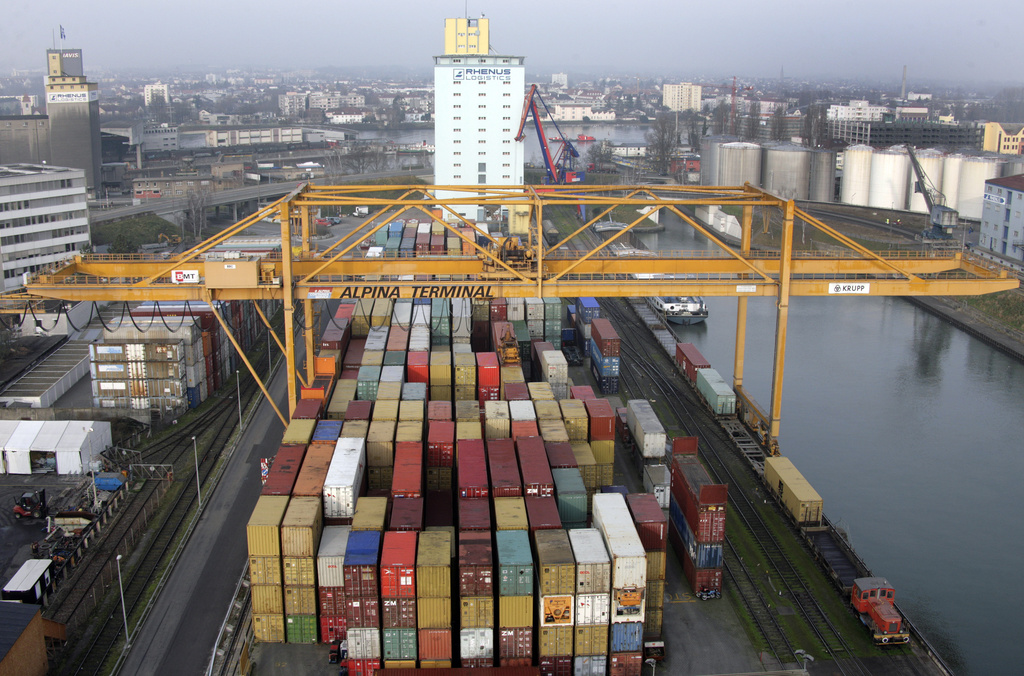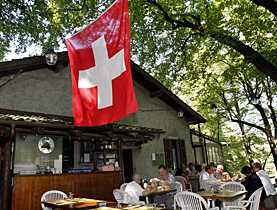Swiss economy spills over the borders

Of Switzerland’s 26 cantons, 17 border on other countries, and hundreds of thousands of commuters enter Switzerland to work every day.
The border regions of Germany, France and Italy are more important to the Swiss economy than China, the United States and India, Jean-Daniel Gerber, head of the State Secretariat for Economic Affairs (Seco), told a French newspaper recently.
In other words, the notion of a border has changed. The Swiss economy overflows into the surrounding parts of Germany, France and Italy.
To Switzerland’s north and east, the German states of Baden-Württemberg and Bavaria are economic power houses, whose economies mesh closely with that of Switzerland.
“On the European scale, the two neighbours form a single entity, a very strong economic region, where the border scarcely exists,” said Daniel Heuer, head of export marketing at the Germany-Switzerland Chamber of Commerce.
The industries of the two regions complement each other in areas like microtechnology and microelectronics.
Of the around 2,000 Swiss companies established in Germany, more than half are to be found in this border area. They include Novartis (pharmaceuticals), Swiss Re (re-insurance) and Von Roll (power generation). The authorities in the two German states estimate that Swiss direct investments amount to more than SFr15 billion ($12.9 billion).
Looking west
The situation is slightly different in the west, where Switzerland borders on the Rhône-Alpes region of France.
There is lively cross-border commuter traffic, with around 52,000 French citizens working in the Geneva region, and a further 25,000 or so Swiss living in France while working in Switzerland.
Some 400 Swiss businesses are thought to have branches across the border. But officially, there are about 60 with a workforce of more than 50, according to Michel Failletaz, Swiss consul general in Lyon.
They include Migros (retailer), ABB (engineering) and Roche (pharmaceuticals).
But there is a problem over where these companies pay taxes.
“We cannot say that both sides of the border form a single industrial entity,” Failletaz told swissinfo.ch. “The principle of bi-localisation is ready on paper, but has made little progress on the ground.”
Bi-localisation is the system allowing companies to have a headquarters and a branch on either side of the border. A set of rules lays down how much of the profit is taxed in each country.
Down south
At the opposite end of the country, the Italian-speaking canton of Ticino and the northern Italian region of Lombardy formed the Regio Insubrica cooperation community back in 1995, and are also participating in the European Union’s Interreg programme.
Switzerland’s ambassador to Italy describes the frontier not as a boundary, but as a line linking the two areas. However, not everyone agrees this is the case.
“Lombardy is a region with a population of ten million, of whom six million live north of Milan,” Ticinese economist Remigio Ratti told swissinfo.ch.
“We have to keep repeating these figures to show that Ticino’s future is inconceivable other than as a Swiss territory within the large metropolitan area of Milan. But in people’s heads, whether they live in Ticino or in [the Italian cities of] Como and Varese, the border still has a very strong role of keeping the sides apart.”
But if it doesn’t overcome this “border challenge”, Ticino will be marginalised, Ratti believes.
A win-win situation
“These [foreign] border areas have realised that their future lies in increased trade,” explained Tony Moré, an expert at the State Secretariat for Economic Affairs (Seco). “It is in their interest to move towards greater integration in order to benefit from Switzerland’s dynamism and to attract activities with greater added value.”
Switzerland benefits too. The French, Italian and German border regions are of major economic importance and are also home to the largest concentrations of Swiss in these countries.
Regional intergovernmental bodies promote cross-border relations between Switzerland and its three main neighbours. But Ratti thinks not enough is being done.
“These regions are going to gain in importance, and I think it’s scandalous how little the Swiss government and parliament allocate to the Interreg projects,” he said. “The latest generation of Interreg projects are 90 per cent financed by the EU and neighbouring states. And we can’t even put up ten per cent!”
Pierre-François Besson, swissinfo.ch (Adapted from French by Julia Slater)
Swiss exports to Baden-Württemberg and Bavaria are worth around SFr20 billion a year, the same as to the US.
They include sub-contracting for the motor vehicle industry, machinery, chemicals and pharmaceuticals, medical technology, IT and software
Annual exports to the Rhône-Alpes region, are worth about SFr2.3 billion – nearly as much as those to India.
The main exports are chemicals and plastics, mechanical equipment, electronics, electricity and metal products. Switzerland is the region’s seventh biggest exporter and importer.
Annual exports to Lombardy are worth some SFr5.2 billion.
The main items are pharmaceuticals, watches, machinery, metal items and food, plus financial services.
Switzerland’s imports goods worth SFr 6.3 billion per year from Lombardy – 68 % of its total imports from Italy.

In compliance with the JTI standards
More: SWI swissinfo.ch certified by the Journalism Trust Initiative













You can find an overview of ongoing debates with our journalists here . Please join us!
If you want to start a conversation about a topic raised in this article or want to report factual errors, email us at english@swissinfo.ch.